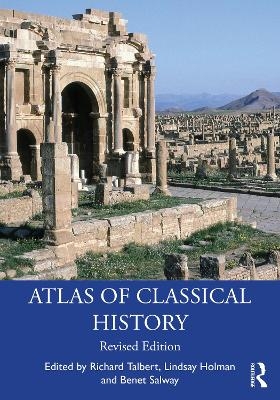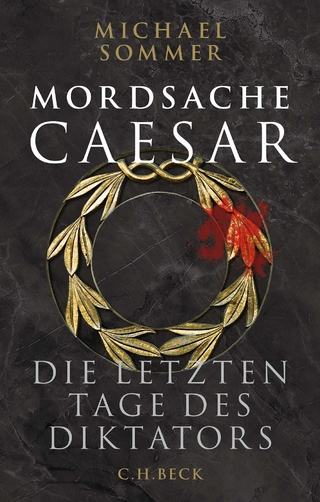
Atlas of Classical History
Routledge (Verlag)
978-1-138-78583-0 (ISBN)
Featuring over 130 colour maps of ancient physical and human landscapes spanning Britain to India and deep into the Sahara, this atlas is a compact kaleidoscope of peoples, migrations, empires, strife, cultures, cities and travels from Greece’s Bronze Age to Rome’s fall in the West.
This revised edition of the Atlas of Classical History equips readers with a clear visual grasp of the spatial dimension, a vital aspect for understanding history. Users gain insight into the formative roles of physical landscape – seas, rivers, mountains, deserts – in Mediterranean peoples’ development. The maps in all their variety of scope, scale and colour offer an absorbing means to track the growth of states on the ground, especially their relationships, conflicts, urbanization, communications and cultures. Each map is enriched by readily identifiable symbols and concise accompanying texts, as well as recommendations for further reading. With its vast geographical sweep in a compact format, this book is a comprehensive reference work primarily aimed at non-specialists.
With updated text and thoroughly revised maps now presented in colour, the Atlas of Classical History remains an essential reference volume for all those interested in the civilizations of ancient Europe, North Africa and Western Asia, as well as for students and scholars of ancient Greek and Roman history.
Richard Talbert is Research Professor of History at the University of North Carolina, Chapel Hill, US. His publications include the Barrington Atlas of the Greek and Roman World, Rome’s World: The Peutinger Map Reconsidered, Challenges of Mapping the Classical World and The Romans from Village to Empire. Lindsay Holman is Visiting Assistant Professor of History at Mercyhurst University (Erie, Pennsylvania, US). Her research explores the materiality of inscriptions naming slaves from the Roman Empire. She is the author of "Two Unpublished Tesserae Nummulariae from the Lewis Collection, Cambridge," ZPE 210 (2019). Benet Salway is Senior Lecturer in Ancient History at University College London, UK; a director of the British Academy ‘Projet Volterra’ on Roman Law; and a contributor to L’Année épigraphique. He has published widely on aspects of Greco-Roman geography, including "Putting the world in order" (Chicago, 2012).
Maps; Battles, Cities, Regions, Shrines to around 300 BCE: Locator; Egypt and the Near East, 1200-500 BCE; Troy: Citadel; Troy: Lower Town; Neolithic and Bronze Age Greece and Aegean; Neolithic and Bronze Age Crete; Neolithic and Bronze Age Cyprus; Knossos; Mycenae: Citadel; Mycenae Outside the Citadel; Homer’s World; Mainland Greece in Homer’s Epics; Iron Age Greece; Greek Colonization, 800-500 BCE; Archaic Greece; Persian Empire, 550-330 BCE; Persepolis; Marathon, 490 BCE; Persian Wars; Thermopylae, 480 BCE: Ephialtes’ Route; Artemision, 480 BCE; Salamis, 480 BCE; Plataea, 479 BCE; Greece and the Aegean (Hellespont inset); Classical Greece; Cimmerian Bosphorus; Olympia; Attica; Athens; Classical Athens (5th and 4th Centuries BCE); Roman Athens; Delphi; Sparta; Miletus; Priene; Halicarnassus; Akragas; Greek and Punic Sicily; Athenian Empire; Greek Dialects around 450 BCE; Peloponnesian War, 431-404 BCE (Sicily inset); Pylos/Sphacteria, 425 BCE; Syracuse (and Athenian Siege, 415-413 BCE); Explorers; Anabasis (Spring 400 to Winter 400/399 BCE); Leuctra, 371 BCE; Second Athenian League; Chaeronea, 338 BCE; Growth of Macedonian Power, 359-336 BCE; Alexander’s Campaigns, 334-323 BCE; Granicus River, 334 BCE; Issus, 333 BCE; Tyre, 332 BCE; Gaugamela, 331 BCE; Hydaspes River, 326 BCE; Alexandria Oxiana (Ai Khanoum); Alexandria; Hellenistic World: Kingdoms; Hellenistic World: Aegean; Hellenistic World: Asia Minor; Hellenistic World: Syria-Egypt; Pergamum; Delos City; Delos Centre; Delos Island; Etruria and Etruscan Expansion; Early Italy and its Neighbours; Peoples of Italy, and their Languages to the First Century CE; Latium, 600-300 BCE; Campania; Roman Expansion in Italy to 241 BCE; Cosa; Rome by 300 BCE; Roman Colonization in Italy to the Time of Augustus (Campania inset); Second Punic War (First Punic War inset); Cannae, 216 BCE; Zama, 202 BCE; Roman Campaigns in the Iberian Peninsula, 218-133 BCE; Numantia: Roman Siege, 133 BCE; Numantia: Region; Rome in the Late Republic; Rome’s Empire around 60 BCE; Roman Campaigns, 58-30 BCE; Actium, 31 BCE; Augusta Praetoria (Aosta); Italy from Alps to Campania (including Corsica); Italy from Apulia to Bruttium; Sicily and Sardinia; Rome’s Empire and Beyond: Locator; Rome at the Death of Augustus, 14 CE; Environs of Imperial Rome; Ostia; Portus; Second Battle of Cremona, 69 CE; Pompeii; Herculaneum; Italian Towns with Alimentary Schemes; Rome at the Death of Trajan, 117 CE; Rome’s Empire around 60 CE; Britain; Hadrian’s Wall; Antonine Wall; Iberian Peninsula; Vipasca; Thamugadi (Timgad); Africa; Lepcis Magna; Africa Proconsularis and Numidia; Cyrene; Lutetia Parisiorum (Paris); Gaul; Germany; Rhine-Danube Limes, 40-260 CE; Danube-Black Sea; Crete; Greece; Cyprus; Aphrodisias; Asia Minor; Paul’s Journeys; Syria-Persian Gulf; Antioch (Syria); Dura; Jerusalem/Aelia Capitolina, 2nd-3rd Centuries CE; Jerusalem on Madaba Map; Judaea; Masada (and Roman Siege, 73 CE); Egypt; Arabia; India; Rome’s Empire around 211 CE; Circuit of the Roman Empire by Aurelius Gaius, 285-299 CE; Etesian Winds and Sea Currents; Sea Routes in Diocletian’s Edict on Prices; Rome at the Death of Constantine, 337 CE; Split; Constantinople; Rome’s Empire around 314 CE; Christianity by the Early Fourth Century; Roman World on Two Portable Sundials; Barbarian Invasions of the Roman Empire, 370-500 CE; Roman Empire and Successor Kingdoms around 530 CE; Further Reading; Gazetteer.
| Erscheinungsdatum | 20.02.2023 |
|---|---|
| Zusatzinfo | 177 Halftones, color; 177 Illustrations, color |
| Verlagsort | London |
| Sprache | englisch |
| Maße | 178 x 254 mm |
| Gewicht | 640 g |
| Themenwelt | Geisteswissenschaften ► Archäologie |
| Geschichte ► Allgemeine Geschichte ► Altertum / Antike | |
| ISBN-10 | 1-138-78583-0 / 1138785830 |
| ISBN-13 | 978-1-138-78583-0 / 9781138785830 |
| Zustand | Neuware |
| Informationen gemäß Produktsicherheitsverordnung (GPSR) | |
| Haben Sie eine Frage zum Produkt? |
aus dem Bereich


